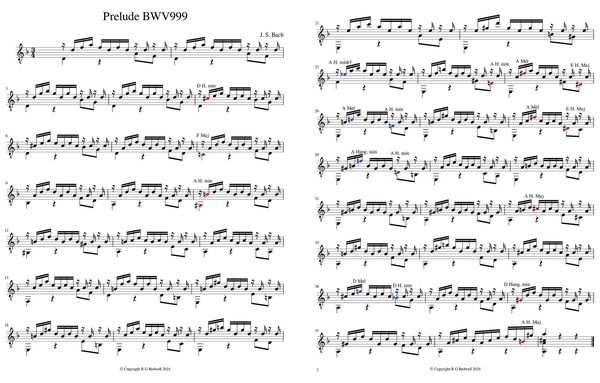Hidden complexity in Prelude BWV 999: Redux
- rbedwell3
- Aug 12, 2024
- 3 min read
The prelude in D minor is a favourite of guitar students as it is relatively easy to play for intermediates, but in its 43 bars lies a hidden world.
This short movement contains music comprised of 6 scales:
Major (1 2 3 4 5 6 7)
Harmonic minor (1 2 b3 4 5 b6 7)
Harmonic minor b5 (1 2 b3 4 b5 b6 7)
Melodic (1 2 b3 4 5 6 7)
Harmonic Major (1 2 3 4 5 b6 7)
Hungarian minor (1 2 b3 #4 5 b6 7)
The first page is pretty quiet, just a change from D Harmonic minor forward to A Harmonic minor, but from bar 20 Bach introduces an interesting set of modulations: Bar 20 - 26:
A Harmonic minor - A Harmonic b5 – A Harmonic minor
This is what I call a ‘wave sequence’, where the composer is setting out to construct a sequence that has an alteration then returns to the first scale. Often this type of sequence is repeated with other scales in the piece to create the sense of familiarity in the listener.
This is then followed by a ‘symmetrical sequence’:
A Harmonic minor - A Melodic - E Harmonic Major - A Melodic - A Harmonic minor
A symmetrical sequence like this starts out at a certain point, in this case A Harmonic minor, reaches its apex, E Harmonic Major, and then returns via the same route, with the E Harmonic Major acting as the pivot point, resolving to the same scale that was used at the start of the sequence.
He then repeats this sequence with a slight variation in bars 28 - 29:
A Harmonic minor- A Melodic - E Harmonic Major - A Hungarian minor - A Harmonic minor.
The repetition of the sequence creates the feeling of familiarity in the listener which is then interrupted in the change from E Harmonic Major to A Hungarian minor. Hence, the name of ‘interrupted symmetrical sequence’ is given to this type, a repetition of a symmetrical sequence but with the series of scales being interrupted.
So far, we have a wave sequence, a symmetrical sequence and then an interrupted symmetrical sequence, making the music far less random or spur of the moment than one might think.
The final sequence of modulations take the music back to the key of D minor before finally resolving to A Major via the A Harmonic Major scale: bars 34 - 43:
A Harmonic minor - A Harmonic Major - D Melodic - D Harmonic minor - D Hungarian minor - A Harmonic Major.
This is actually a circular sequence that is simply interrupted at the end to resolve to the parallel A Harmonic Major instead of A Harmonic minor. You can see why it is given the name of an ‘interrupted circular sequence’.
So the whole piece is simply four different sequences one after the other:
Wave – Symmetrical – Interrupted Symmetrical – Interrupted Circular
You can now see, that this is another sequence of a higher order. The individual scale modulations creating a sequence, and then a chain of different sequences forming a larger sequence in its own right:
Wave - Symmetrical – Symmetrical – Circular
All of this analysis has been possible by simply looking at the alterations of the roots of the modes involved in the music. Quite a lot going on in this little piece I'm sure you'll agree.








Comments